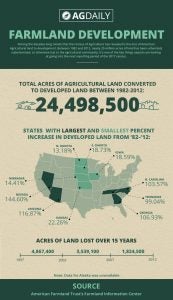The American Farmland Trust spent years researching and compiling the most comprehensive assessment ever undertaken of farmland and ranchland lost to development. It found that, in less than one generation, the United States irrevocably developed nearly 11 million acres of its best land for intensive food and crop production.
In too much of the nation, it seems, there’s no turning back.
The nonprofit’s report, titled “Farms Under Threat: The State of America’s Farmland” and released today, is an in-depth 56-page document that should serve as a wake-up call to the public about what is being swallowed up by urban and suburban sprawl. Our nation’s landscape must balance housing and energy needs, as well as transportation and food resources, all while trying to conserve resources. AFT thinks that the current trajectory is a dangerous one that needs to be addressed immediately.
“Through thoughtful and carefully implemented land use and agricultural policies, the nation can protect farmland and strategically direct development away from critical agricultural resources while nourishing the land with conservation practices and helping the farmers and ranchers who manage this landscape to thrive,” the report says.
Between 1992 and 2012, tens of millions of acres of agricultural land were irreversibly lost to development — a size equivalent to losing most of Iowa or New York. A continuation of this trend is particularly troublesome for crops such as fruits, tree nuts, berries, vegetables, melons, poultry, and eggs, all of which are commonly sourced from metropolitan counties and adjacent areas.
Much of what’s at stake is the land resources and diversity that make the United States competitive on a global stage while ensuring the nation’s ability to meet the needs of a growing socio-economic standard of living.
“Agricultural land contributes to state and local economies, supplies lucrative export markets, and bolsters the nation’s balance of trade,” said the American Farmland Trust, noting that related ag industries combine to contribute $992 billion to the annual U.S. GDP. “These exceptional natural resources also sustain valuable wildlife habitat, provide flood control and fire suppression, scenic views, and resources for hunting and fishing.”
The report is as much about looking at the consequences of the past as it about looking to the needs of the future. With a global population by 2050 expected to be 50 to 70 percent higher than it is now, there is a clear need to keep the nation’s most optimal farmland in production. These are the areas where the soils, micro-climates, growing seasons, and water availability combine to allow intensive production with the fewest environmental impacts.
The effects on the climate are also a factor in the AFT’s analysis, because low-density residential development has been found to be a substantial contributor to carbon emissions through transportation needs alone. The American Farmland Trust cites emerging studies that show the average greenhouse gas emissions from urban land uses are up to 70 times higher than those from cropland.
Additionally, as development has happened in the recent decades, agricultural lands have been disproportionately affected. More than 70 percent of urban development and 62 percent of all development took place on such land.
If the nation’s most productive lands are swallowed by sprawl, cultivation will have to shift to lower-quality farmland, which problematically can put more pressure on water, soils, and biodiversity. The AFT offers solutions that require real action to mitigate further damage: strengthen farmland protection policies, fund programs that monitor threats to land resources, and get a stronger federal commitment to sustain America’s land.
There are more than 1 billion acres of land being currently managed by farmers and ranchers that are at stake. It’s the reason that the American Farmland Trust has added two words onto its ubiquitous rallying cry, which now reads: No Farms. No Food. No Future.

Ryan Tipps is the managing editor for AGDAILY. He has covered farming since 2011, and his writing has been honored by state- and national-level agricultural organizations.



